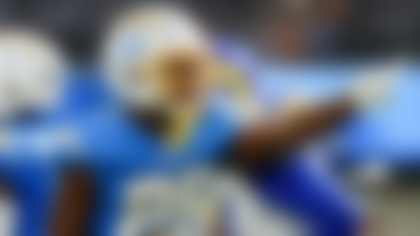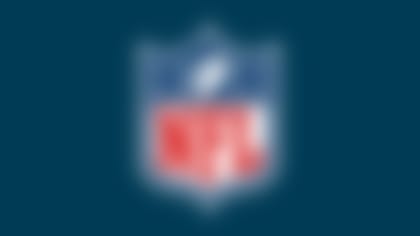What's wrong with the New York Giants' defense?
That's the question being echoed around the league after the Giants played like midgets on the defensive side of the ball the last three weeks. The unit has surrendered 825 passing yards and 112 points in the past three games -- all losses. The Giants have also been burned for eight touchdowns in that span and come up with only one interception.
Although the defense was expected to undergo a transition following coordinator Steve Spagnuolo's departure in the offseason, the promotion of linebackers coach Bill Sheridan had appeared to minimize any slippage. Initially, it seemed to have worked. The Giants held four of their first five opponents to fewer than 17 points and had the look of an elite defense.
In Week 6, however, a 48-27 trouncing by the New Orleans Saints exposed several weaknesses on defense, and since then teams have been attacking those flaws relentlessly. In the Saints shellacking, Drew Brees used a variety of personnel packages and spread formations to pick apart the Giants' secondary with a host of intermediate and deep throws that led to a 369-yard passing day.
While other teams had used the tactic against the Giants earlier in the season, the Saints' success throwing the ball down the field led the Arizona Cardinals and Philadelphia Eagles to the air with wide-open sets, and the team had no answer for the barrage of throws unleashed against its defense.
Earlier in the season, the Giants were able to depend on a fierce pass rush to disrupt the rhythm of the opponent's passing game. Justin Tuck, Osi Umenyiora and Mathias Kiwanuka routinely harassed quarterbacks in the pocket and took turns accumulating sacks off the edge. The trio accounted for 8.5 sacks in the Giants' first five games, and their relentless pressure led to quarterbacks throwing errant passes from the pocket.
However, opponents have essentially shut down the formidable threesome the past three weeks, as those vaunted rushers have only tallied two sacks in the team's three-game skid, and their ineffectiveness has forced the Giants to dial up the blitz with their linebackers and safeties.
While this aggressive approach has been a staple of the Giants' defensive game plan the past few years, the tactic has failed miserably due to a host of injuries in the back end. Cornerback Aaron Ross' nagging hamstring injury has thrust Terrell Thomas into the lineup, and the second-year cover man has struggled keeping up with receivers on the outside. Although he has delivered a handful of big plays this season, Thomas has also given up his fair share due to spotty coverage or inconsistent tackling.
But Thomas' woes pale in comparison to those of C.C. Brown. The fifth-year safety has been routinely exploited in coverage since replacing the injured Kenny Phillips. Brown, who was not regarded as a solid cover man during his time with the Houston Texans, has blown coverage assignments and routinely been out of position on deep throws. Although the team has attempted to protect him by playing more two-deep zone coverage, Brown's inability to get off the hash has resulted in numerous deep throws against the Giants' suddenly vulnerable defense.
While the Giants' recent skid has left the NFC East up for grabs, the team is on the verge of regaining some of the lost pieces that had given it the look of a title contender. Defensive tackle Chris Canty and linebacker Michael Boley, two of the Giants high-profile offseason additions, are slated to return this week, and their insertion into the lineup should stabilize the Giants' front seven. They'll be needed to compete with the San Diego Chargers' high-octane offense.
Canty gives the team an imposing interior player who is capable of rushing the passer up the middle. His ability to command attention on the inside should free up Tuck, Umenyiora and Kiwanuka. In Boley, the team gets a speedster who has the athleticism to wreak havoc as a blitzer or in coverage. His versatility gives Sheridan another weapon to use in the team's base and sub-packages.
Throw in Ross' imminent return, and the Giants will finally have the weaponry to attack opponents in customary fashion.
In a division that will be ultimately decided by the best defense, the Giants can only hope that the added firepower leads to a sudden revival.
Packers' protection problems
After watching the Minnesota Vikings' pass rush dismantle the Green Bay Packers for the second time this season, it would be easy to pin the blame on the team's offensive line. But Aaron Rodgers is as much to blame for the battering he endures in the pocket.
While it is hard to be critical of a quarterback who touts a league-leading 110.4 passer rating and sports an impressive 14:2 touchdown-to-interception ratio, the fact that he has been taken down a league-high 31 times suggests he is holding on to the ball too long. Video evidence agrees.
Rodgers, who leads the league in yards per attempt (8.8) and completions over 40 yards, is a fan of the deep ball and his ability to connect on the vertical throws makes the Packers' offense such a big-play threat. It also makes them vulnerable to protection breakdowns. Waiting on those big plays to develop takes a lot of time in the pocket and the team's reshuffled offensive line is incapable of holding out elite rushers for extended periods of time. Thus, the onus falls on Rodgers to get rid of the ball quickly before the rush gets home.
The Packers' offense features a number of three- and five-step drops that call for a pure progression-read system for the quarterback. Rodgers is asked to drop to his assigned depth, read the triangle (three receivers involved in the play), and deliver to the open man on time. The key to making the offense work is having a triggerman capable of making quick decisions while trusting the reads of the systems. If he stays true to the concept, he will complete a high percentage of his passes and connect on the big plays that eventually emerge when defenders jump underneath routes.
While Rodgers has shown that he is capable of staying true to the system, his big-play desire sometimes leads to senseless sacks. If he eventually learns how to avoid the negative plays and punishment that come with holding onto the ball and taking sacks, he will continue his ascension to the ranks of the elite without the soreness that comes with getting pummeled in the pocket.
DeSean Jackson's revenge
After watching DeSean Jackson emerge as one of the league's premier playmakers in his second season, several personnel men around the league have to be second-guessing their decisions to bypass the sensational big-play artist in the 2008 NFL Draft.
The second-year star was the seventh receiver taken in the draft (No. 49 overall) despite enjoying a stellar three-year career at Cal. While scouts cited Jackson's slender frame and reported cocksure attitude as reasons for his plummet down draft boards, the fact that he posted one of the fastest 40 times at the combine should've been enough to cement his status near the top of the draft.
Since stepping onto the field a season ago, Jackson has terrorized opponents with his explosive playmaking abilities. He has hauled in 86 receptions for 1,413 yards (16.4 average), with eight scores in 22 career starts. He has also scored two touchdowns on reverses and tallied two punt return scores in his brief career.
If those numbers aren't eye-popping enough, try this one: Jackson on Sunday joined Hall of Famer Elroy "Crazy Legs" Hirsch as the only players in NFL history to score six touchdowns of 50 yards or more in the team's first seven games.
"I think that everybody thought he would be an explosive player," said an NFC personnel man. "But everyone was scared off by reports regarding his demeanor. However, if given the opportunity to do it over again, I'm sure that everyone would love to have him in the lineup."
I wonder if the Rams (Donnie Avery, No. 33 overall), Redskins (Devin Thomas, No. 34), Packers (Jordy Nelson, No. 36), Bills (James Hardy, No. 41), Broncos (Eddie Royal, No. 42) and Bengals (Jerome Simpson, No. 46) feel the same way.
Peppers worth his salt
The murmurs regarding Julius Peppers' exorbitant compensation as the Panthers' franchise player have subsided after watching Carolina's defensive end enjoy a sensational four-game stretch that has cemented his status as one of the dominant pass rushers in the game.
After a pedestrian start to the season, Peppers has amassed six sacks, two forced fumbles and an interception returned for a touchdown in leading the Panthers to three wins in their last four games. Making the feat more remarkable is the fact that Peppers has been able to dominate games off the edge without the presence of an established complementary rusher on the opposite side.
Peppers, who is earning $16.7 million this season under the Panthers' franchise tag, was chided by fans and teammates alike for only producing one sack during the team's first three games. At over $1 million a start, the production didn't match up to his compensation and his critics were out in full force. That he has flourished over the last four weeks is nothing new to Peppers, who has always been one to accumulate his sacks in bunches, and his freakish athleticism produces negative plays that don't always register on a stat sheet.
Given Peppers' continual dominance and the financial impact of DeMarcus Ware's recent contract extension (six years, $78 million, $20 million guaranteed) on the free-agent landscape, the Panthers may have to cough up a hefty sum to retain the services of one of the game's top rushers.
Is Austin a No. 1 receiver?
Right now, Miles Austin is the Cowwboys' No. 1 receiver, but is he a No. 1 receiver by NFL standards?
We might want to hold off on the coronation of Austin, who is enjoying the most productive three-game stint by a receiver making his first three career starts (21 receptions, 482 yards, five touchdowns). NFL scouts are. They're not ready to tout Austin as an upper-echelon receiver just yet.
"He has been outstanding the past few weeks, but I still view him as more of a complementary player than a No. 1 receiver," said an AFC personnel man. "He is a tough guy due to his special-teams background and shows good running skills after the catch, but I don't know if he is the kind of receiver that will ever attract double coverage."
"I've been waiting for him to come back to earth," said an NFC scout who recently watched the Cowboys. "He has done a great job of taking advantage of his opportunities, but he is benefitting from playing with a talented cast around him. Jason Witten attracts all of the attention in the middle, and defenses still have to worry about their dangerous backs leaking out of the backfield. Granted, he is doing the job that should fall to Roy Williams, but I wouldn't regard him as an elite receiver by any means."
While Austin has been a key to the Cowboys' offensive explosion in recent weeks, his sensational production has come against two teams ranked among the five worst pass defenses (Atlanta at 31, Kansas City at 28), and another unit that is in the middle of the pack (Seattle at 18). And none of those teams have a premier corner with the skills to challenge him in one-on-one situations.
With big games against the Philadelphia Eagles (Asante Samuel), Green Bay Packers (Al Harris and Charles Woodson) and Washington Redskins (DeAngelo Hall) on the horizon, we may soon see if Austin is ideally suited to play the starring role in the Cowboys' pass attack.




